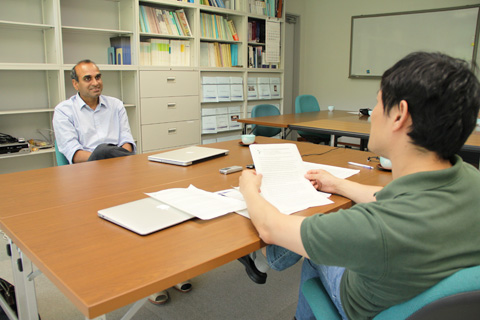2012年8月号 [Vol.23 No.5] 通巻第261号 201208_261003_en
Interview in the front line of climate change
Improving the measurements and modeling tools
for a better understanding of greenhouse gases fluxes
- Dr. PATRA Prabir
Senior Scientist, Environmental Biogeochemical Cycle Research Program, Japan Agency for Marine-Earth Science and Technology - Specialty field: Forward and inverse modeling of greenhouse gases
- Interviewer: Dr. TANIMOTO Hiroshi, Head of the Global Atmospheric Chemistry Section, Center for Global Environmental Research
Recently, climate change has become a serious concern, and a movement from mere scientific clarification to concrete counter-measures and international negotiations has been witnessed. Nevertheless, are the implications of global warming really understood? Are the paths towards a Low-Carbon Society in Japan and around the world made sufficiently clear? What are the next steps to be taken according to climate change researchers and what do they mean to us? In this column we are trying to find the answers to “Climate Change Research Today and Tomorrow” by interviewing researchers in the front line of the climate change field about their research projects and their background.
Dr. PATRA Prabir
- 1968 Born in Tikayetpur, West Bengal, India
- 1998 Ph.D. in Physics, Gujarat University, Ahmedabad
- 1998–2001 Research Staff Member, IBM India Research Laboratory, New Delhi
- 2001–2005 Post. Doc., Frontier Research System for Global Change, JAMSTEC
- 2005–2007 Research Scientist, Frontier Research System for Global Change, JAMSTEC
- 2007–2012 Senior Scientist, Research Institute for Global Change, JAMSTEC
Given a chance, I am open to playing any (non-competitive) sports. Enjoy travelling and pass time with family and friends.
Tanimoto: Thank you for coming to NIES. Let me start with the first question. You studied stratospheric chemistry and dynamics in graduate school, but currently you are engaged in research on carbon cycle and modeling. What made you change your specialty?
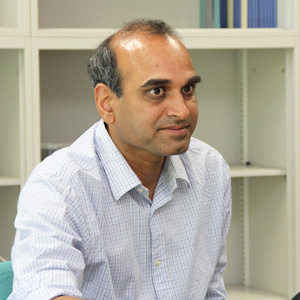
Patra: Job opportunity and academic challenges. Firstly you need to find your next job, and secondly, you want to have a job that is more challenging, as you want to do something interesting. Immediately, following the submission of my Ph.D. thesis in 1997, I was lucky to get a job offer from the newly established IBM Solution Research Center (now India Research Lab.) in New Delhi. That was a daunting task—I was employed to work on weather forecasting models using IBM deep computing machines. I had no formal education in computer science or programming. We learnt various fundamentals (weather and climate, the use of numerical models and “work ethics”), but could not progress much in terms of research.
Tanimoto: So that job was not science.
Patra: It was science, weather forecasting using numerical models. IBM has a long history of doing weather computing. For example they had a contract for doing the weather forecasting for the 1996 Olympics in Atlanta to help them decide which time to hold which kind of sport, where to hold them: indoors or outdoors, how much the wind speed will be for the runners, etc. So we were hired to do a similar work for India on a routine basis, and at the same time, to understand the physics/microphysics of the Indian monsoon and tropical cyclones.
Tanimoto: But you found it boring?
Patra: No, not boring, we had different challenges. At that time, the industry and government in India did not often collaborate on common scientific agendas.
Tanimoto: That work was actually very different from carbon cycle and stratospheric chemistry, and you are basically a physicist, aren’t you? And this question is actually connected to why you came to Japan 10 years ago.
Patra: Yes, to find academic challenges I was kind of forced to look beyond my motherland, so I applied to JAMSTEC’s Frontier Research System for Global Change (now Research Institute for Global Change). I didn’t know what exactly I would be working on, except that the position was open in the atmospheric composition research program. I was offered a job to work on CO2 forward and inverse modeling. I had never measured or simulated CO2. Life is not always predictable! So I toiled a couple of years (2001–2002) to learn what the challenges in CO2 research were. To start with, I chose to apply the knowledge gained in the IBM-research on network optimization to identify locations ‘most desirable’ for expanding the CO2 measurement network. It was also the time when we explored about satellite sensor specifications for reducing uncertainties in surface flux estimations by inverse modeling. That was for the first time I collaborated with NIES scientists. Our results suggested that measurements of CO2 profiles in the upper troposphere and stratosphere are perhaps not the best way for developing a satellite sensor. Around 2003 or so, I was able to think about carbon cycle science from the inverse modeling point of view.
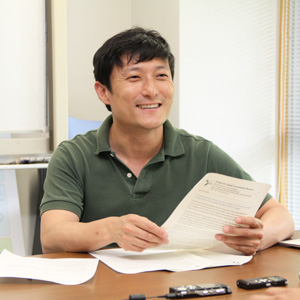
Tanimoto: So that’s the start of the carbon cycle work 10 years ago. And now can you tell us about your present research? What is the research theme that you are currently most actively involved in and that you find most interesting?
Patra: One of my primary interests lately has been methane chemistry. I have some experiences in methane and nitrous oxide flux measurements across the sea–air interface and associated processes. The chemistry of methane in the atmosphere is challenging, but its flux variability is simpler than that of CO2 on space/time scales. It helps you to eliminate one level of uncertainty. CO2 has negative sources and sinks and varies by the hour, which is much more complicated to model. On the other hand, methane has mostly positive emissions. There are very few measurements for OH, so you cannot talk about the affect of OH interannual or inter-hemispheric variation on methane chemistry. For methane simulations we can fairly estimate surface emissions and the global distribution of OH, and put those, together with the known chemical reactions, into a chemistry-transport model for methane simulations. We have now shown, using multiple chemistry-transport model simulations, that the methane global budget and growth rate variations during the 1990–2007 can be explained by slowing down the increase rate of anthropogenic emissions and interannual variations in emissions from wetlands and biomass burning.
Tanimoto: So you can now focus more on emissions by constraining the OH. Last week I was on an expert workshop where we had a discussion about methane from TransCom inputs. Can you tell me a little bit more about the TransCom work?
Patra: We still work closely within the TransCom communities for the estimation of CO2 fluxes by inverse modeling and data assimilation. The forward transport model errors are found to be one of the major barriers to estimate CO2 fluxes at the sub-continental region size at high confidence. I think it is crucial for us to invest time and energy for bringing in other important greenhouse gases and chemical tracers that can help us to disentangle the transport model uncertainties. The TransCom-CH4 intercomparison experiment is a shot at that. We simulated sulfur hexafluoride (SF6), Radon-222, and methyl chloroform (CH3CCl3) for providing constraints on inter-hemispheric transport, vertical transport and OH distribution, respectively.
Methane is also a kind of bridge between chemistry and carbon cycle. We want to focus more on methane emissions, transport and chemistry. I am personally quite excited about the performance of our newly developed ‘online’ chemistry-transport model (i.e., ACTM), which we have developed for representing the boundary layer processes, convective transport and large-scale advective transport. The next five years of our research will be spent on making use of ACTM as much as possible and expanding it to a variety of applications.
Tanimoto: So you are excited about methane and transport models.
Patra: Yes. Since I was formally educated in non-CO2 greenhouse gases (CH4, N2O, SF6, CFCs, HCFCs etc.), it was relatively easy for me to diversify the modeling tools to the non-CO2 gases and contribute to further developments of ACTM.
Tanimoto: You are also working together with Machida-san, on the CONTRAIL project, right?
Patra: Last year, we completed the CONTRAIL CO2 Transport model inter-comparison. We are doing the CONTRAIL ASE (and CARIBIC too) data analysis for checking how well our model performs in the upper tropospheric altitudes for CO2, CH4, N2O and SF6. If you use only one tracer, it is difficult to identify errors for model transport, chemistry or fluxes. Our next target in TransCom would be to simulate CO2, methane and SF6 simultaneously.
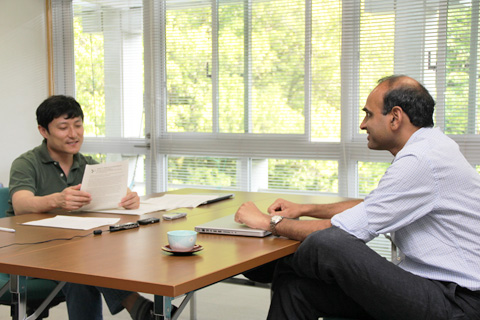
Tanimoto: Can you talk a little bit about CO2 inverse modeling? Do you think that modeling research and observations are unsatisfactory at present?
Patra: Yes and No. I think, both communities are keeping a reasonably good pace in terms of making progress to bring in new constraints on sources and sinks estimation by inverse modeling. Although we understand some things about the CO2 fluxes from the inverse modeling and how the interannual variations on a regional scale behave, the net fluxes are obviously still difficult to discuss. It’s not only the measurements; I think the forward modeling and how we set up the inversion system have to improve. There are so many measurements; in some regions, for example in Japan, measurements are really dense. But the modelers still cannot constrain the fluxes on a continental scale, because the modeling tools are still inferior. The main problem of inverse modeling is our inability to perform a good forward simulation. Only through improved forward simulation we can distinguish between signal and noise. Much of the source signals appear as noise in the present global/regional transport models.
Tanimoto: Even though modeling has rapidly advanced with the development of high-resolution imaging and observations by both aircraft and satellite, you still think that modeling and observations are unsatisfactory, right? Which aspects do you think should be strengthened?
Patra: As I had said, the “transport” part that links the atmospheric concentrations and surface fluxes is still very poorly represented in the models. We need to improve our forward transport modeling capabilities and put more effort into model development and improvement. We also need much help from the terrestrial and ocean ecosystem modelers to provide us realistic fluxes, e.g., most terrestrial ecosystem models produce daily/monthly-mean CO2 fluxes. We need diurnally varying CO2 exchanges from the ecosystem models at a few kilometers resolution as a routine product.
Tanimoto: I see. Now let me talk about observations by NIES. NIES observations cover a broad area by means of airplanes and the GOSAT satellite. As a model researcher, what are your expectations towards NIES’ observational research in the future?
Patra: Expand the measurement programs to greater Asia. Japan, which is the richest Asian nation by far, in terms of both knowledge and money, has societal responsibility. I think there will be no alternatives to in situ measurements for the decades to come. The surface measurement network has to be widened to include more countries in Asia (as well as Africa and South America). Measurements from the air and on the sea are also necessary. I was just talking to Machida-san about collecting data. They have just started collecting air samples from Bangladesh. Just one flask! When I saw it I thought, wow, measurements from Bangladesh! So I think we still need to do more sampling from the source regions, even though some routine observations are carried out over the marine air using the ships of opportunity or oceanographic research vessels. We need to go for more continental, coastal and mountain sites in Asia. I gather China has a national program already in place for making greenhouse gases measurements from a network of sites. To the best of my knowledge, there is no site in northern Southeast Asia, between Vietnam and Myanmar or Bangladesh. That is one thing NIES can take up as an urgent task.
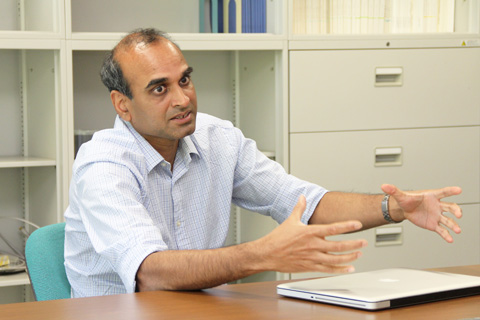
Tanimoto: The Center for Global Environmental Research started air sampling in Indonesia, Borneo a couple of years ago. We are also conducting regular cargo ship observations between Japan and South East Asia with 4 weeks intervals. What about the stations and measurements in India?
Patra: They are mainly Japanese, French and Australian efforts. All the greenhouse gases are measured either by CSIRO (Australia), using a flask sampling system like that of NIES, or by the French scientists. We still don’t have a domestic measurement system. Many things are happening now in Asia, such as land-use change, urban and industrial developments etc., so this is a good time to start recording the state of the regional atmosphere in collaborations with other Asian scientists.
Tanimoto: Do you feel that there are aspects which are important but currently missing in climate change research?
Patra: I feel the climate modelers need to accept the fact that the so called earth system models (ESMs) do not simulate various key aspects of CO2 well, namely, the amplitude of seasonal cycles or sensitivity to interannual climate variations. If a model does not simulate the seasonal cycle well, how can it be used for predicting the future? My point is to bring the climate change scientists to the observational sites. The climate and carbon modelers are talking about future scenarios, but they don’t really look at the observational data as much as needed to understand the model results. How many earth system modelers have compared the CO2 observations with their model simulation? Have you seen any paper on it? I haven’t. I haven’t seen any comparison of seasonal cycles, interannual variation or growth rate of CO2. That thing is still missing.
Tanimoto: So do you really mean that the pure modelers don’t care so much about validation?
Patra: Yes, it has been the trend before, but now it is slightly changing, which is good.
Tanimoto: The “Planet under Pressure” international conference was held in March in London with the theme Global Sustainability. What was your impression of the conference?
Patra: I was not impressed. The problem with the conference was that there were too diverse people. Nobody had time to talk to anybody. People were giving speeches with big (theoretical) ideas and you could not see them again. Those big international conferences must provide an environment where we can talk to each other and have a dialog. The scientific knowledge and database within the developing countries are still poor. So what can you do? You can say: “Your country has high methane emissions, high CO2 emissions. You go and change this or that.” This is the only thing you can do in a conference like this. But is it what we want? No, I don’t think so. We need to build up scientific communities, develop a database and knowledge base, and then we can negotiate. We need to chalk out investments in terms of money and workforce, and a proper developmental direction. I felt, there were no sincere dialogues in the conference. Nobody talked about developing science in the country; no one said a word about what you can learn first before you can change things. That’s why I was not impressed with that conference. Is this the reason that COP keeps failing?
Tanimoto: Yes, that’s true, I get your point. Finally, looking back upon your research career, do you have any message to the next generation young researchers?
Patra: Take challenging jobs and create a friendly working atmosphere, so you can ask for help when you need it! Yes, that’s what I usually tell my colleagues. As you start working together, you should try to understand your colleagues’ attitude. A friendly and trusted atmosphere is necessary for good research. Frank discussions are needed to initiate, develop and mature scientific ideas, before actually conducting the research. So my advice is: have a high work ethics and be friends with your colleagues.
Tanimoto: Thank you.
